Inside The New York Botanical Garden
Esther Jackson
Posted in From the Library on February 24 2017, by Esther Jackson
Esther Jackson is the Public Services Librarian at NYBG’s LuEsther T. Mertz Library where she manages Reference and Circulation services and oversees the Plant Information Office. She spends much of her time assisting researchers, providing instruction related to library resources, and collaborating with NYBG staff on various projects related to Garden initiatives and events.
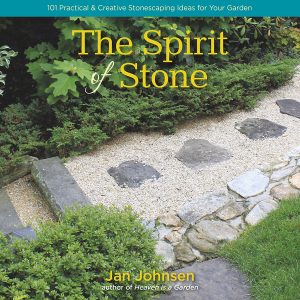 Jan Johnsen’s The Spirit of Stone is a new book from Pittsburgh-based publisher St. Lynn’s Press. Johnsen, an instructor with The New York Botanical Garden’s Adult Education Department, brings 40 years of experience to bear in her newest book. In the introduction of The Spirit of Stone, Johnsen writes:
Jan Johnsen’s The Spirit of Stone is a new book from Pittsburgh-based publisher St. Lynn’s Press. Johnsen, an instructor with The New York Botanical Garden’s Adult Education Department, brings 40 years of experience to bear in her newest book. In the introduction of The Spirit of Stone, Johnsen writes:
Stone is often an overlooked player in a landscape. While we may swoon over the many shapes and colors of plants within a garden, the stone walks and walls stand silently by, perhaps unnoticed. This book shines a light on the beauty and enchantment that natural stone adds to an outdoor setting. It is a celebration of the versatility of solid, durable rock and showcases the many ways stones and stonework can be featured in the landscape.
Read More
Posted in From the Library on February 13 2017, by Esther Jackson
Esther Jackson is the Public Services Librarian at NYBG’s LuEsther T. Mertz Library where she manages Reference and Circulation services and oversees the Plant Information Office. She spends much of her time assisting researchers, providing instruction related to library resources, and collaborating with NYBG staff on various projects related to Garden initiatives and events.
 Unseen City: The majesty of pigeons, the discreet charm of snails & other wonders of the urban wilderness is Nathanael Johnson’s journal documenting the journey of teaching his daughter about the natural wonders of their home city, San Francisco. For me, the beginning of this book was what really shone. Johnson writes about his daughter’s habit as a toddler to ask “that?” when pointing at all number of objects in and features of her environment. In addition to identifying things like “house” or “sky,” Johnson found himself saying “tree” so frequently that he decided to change the way in which he replied to his daughter. He writes:
Unseen City: The majesty of pigeons, the discreet charm of snails & other wonders of the urban wilderness is Nathanael Johnson’s journal documenting the journey of teaching his daughter about the natural wonders of their home city, San Francisco. For me, the beginning of this book was what really shone. Johnson writes about his daughter’s habit as a toddler to ask “that?” when pointing at all number of objects in and features of her environment. In addition to identifying things like “house” or “sky,” Johnson found himself saying “tree” so frequently that he decided to change the way in which he replied to his daughter. He writes:
“I added a rule to complicate the game—I would give the same answer only once per outing. The second time Josephine inquired about a tree, I would have to be more specific. ‘Trunk,’ I would say, or leaves, a branch, a twig, a flower. And it was in this way that I noticed for the first time, though I’d walked by this tree hundreds of times, that it had tiny yellow flowers. The leaves were long and narrow, dark green on the top and, on the underside, nearly white, spotted with black. At the center of each cluster of leaves were tiny yellow flowers. I picked a few (a difficult task because breaking the supple green branch was like tearing a red licorice rope) and stuffed them in my pocket.”
Many fellow naturalists will see themselves reflected, to some extent, in this passage. Johnson and his daughter are curious explorers and hungry to understand more about the organisms in their environment. The real strength of Johnson’s book is how accessible he makes exploring one’s natural surroundings, even in a city. The section “Some Practical Recommendations for Neighborhood Naturalists” is spot on, and easy enough to follow with children.
Read More
Posted in From the Library, Shop/Book Reviews on February 6 2017, by Esther Jackson
Esther Jackson is the Public Services Librarian at NYBG’s LuEsther T. Mertz Library where she manages Reference and Circulation services and oversees the Plant Information Office. She spends much of her time assisting researchers, providing instruction related to library resources, and collaborating with NYBG staff on various projects related to Garden initiatives and events.
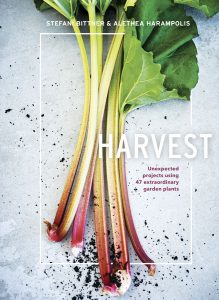
Harvest: Unexpected projects using 47 extraordinary garden plants is a delightful new book from Ten Speed Press. This is the fourth book from author pair Stefani Bittner and Alethea Harampolis whose other titles include The Beautiful Edible Garden, Branches & Blooms, and The Flower Recipe Book. Harvest contains projects related to cooking, craft beverages, beauty care, decorations for the home, and flower arranging. Beautiful photographs by David Fenton accompany the projects. With plants and projects divided into three growing seasons, early (late winter to spring), mid (summer to early fall), and late (late fall to early winter), the book is an eclectic mix of inspiring ideas and ethereal photographs.
Read More
Posted in From the Library on January 30 2017, by Esther Jackson
Esther Jackson is the Public Services Librarian at NYBG’s LuEsther T. Mertz Library where she manages Reference and Circulation services and oversees the Plant Information Office. She spends much of her time assisting researchers, providing instruction related to library resources, and collaborating with NYBG staff on various projects related to Garden initiatives and events.
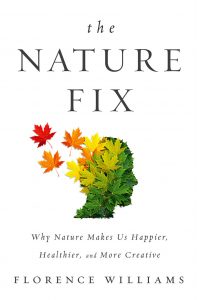 Why do some of us feel happier, healthier, more relaxed, or more energized by nature? Why does an isolated hike in the woods illicit strong feelings of contentment, while a walk in an urban green space devoid of trees fails to inspire the same feelings? Different people have different reactions to time spent in nature, of course, but why do we have reactions at all? Why are some people more affected than others by a babbling brook or a coniferous forest? With these big, somewhat subjective questions in mind, Florence Williams sets out on a journey to find and share answers in The Nature Fix: Why Nature Makes Us Happier, Healthier, and More Creative. The mix between personal and academic voice can be a tough thing for an author to navigate, but Williams accomplishes this hybridity with great skill.
Why do some of us feel happier, healthier, more relaxed, or more energized by nature? Why does an isolated hike in the woods illicit strong feelings of contentment, while a walk in an urban green space devoid of trees fails to inspire the same feelings? Different people have different reactions to time spent in nature, of course, but why do we have reactions at all? Why are some people more affected than others by a babbling brook or a coniferous forest? With these big, somewhat subjective questions in mind, Florence Williams sets out on a journey to find and share answers in The Nature Fix: Why Nature Makes Us Happier, Healthier, and More Creative. The mix between personal and academic voice can be a tough thing for an author to navigate, but Williams accomplishes this hybridity with great skill.
Williams, like other popular science writers, brings readers along for the journey as she researches how different cultures or organizations scientifically quantify health benefits related to nature. Does that sound like a lot to cover in one book? It most certainly is. One of the great strengths of Nature Fix is that the author includes an enormous amount of cited scientific research alongside her more personal travelogue. She is also skilled with setting a scene for readers, providing descriptions that are both visual and engaging.
Read More
Posted in From the Library on January 25 2017, by Esther Jackson
Esther Jackson is the Public Services Librarian at NYBG’s LuEsther T. Mertz Library where she manages Reference and Circulation services and oversees the Plant Information Office. She spends much of her time assisting researchers, providing instruction related to library resources, and collaborating with NYBG staff on various projects related to Garden initiatives and events.
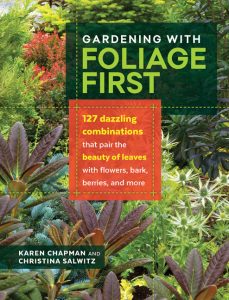 Gardening with Foliage First: 127 Dazzling Combinations That Pair the Beauty of Leaves with Flowers, Bark, Berries, and More is a recipe book for colorful and creative garden designs. The premise of the book is that flowers are lovely, but foliage is the longer-lasting ornament in a garden bed. For gardeners trying to create landscapes with year-round interest, starting with the foliage first is a wonderful approach.
Gardening with Foliage First: 127 Dazzling Combinations That Pair the Beauty of Leaves with Flowers, Bark, Berries, and More is a recipe book for colorful and creative garden designs. The premise of the book is that flowers are lovely, but foliage is the longer-lasting ornament in a garden bed. For gardeners trying to create landscapes with year-round interest, starting with the foliage first is a wonderful approach.
Authors Karen Chapman and Christina Salwitz “scoured gardens from British Columbia to Arizona and Florida to Washington State to find designs to delight, inspire, and embolden [readers] to try new ideas, new plants, and new ways of looking at plant combinations.” The resulting text is both beautiful and functional.
Read More
Posted in From the Library on December 22 2016, by Esther Jackson
Esther Jackson is the Public Services Librarian at NYBG’s LuEsther T. Mertz Library where she manages Reference and Circulation services and oversees the Plant Information Office. She spends much of her time assisting researchers, providing instruction related to library resources, and collaborating with NYBG staff on various projects related to Garden initiatives and events.
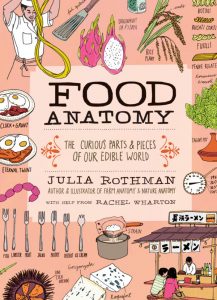 Food Anatomy: The Curious Parts & Pieces of Our Edible World is a delight for those who love food, history, or illustrated dictionaries. If you love all three, you will be in for a treat indeed!
Food Anatomy: The Curious Parts & Pieces of Our Edible World is a delight for those who love food, history, or illustrated dictionaries. If you love all three, you will be in for a treat indeed!
Over the past couple of months, I have developed an interest in graphic novels related to food. When I saw that Julia Rothman, author of Farm Anatomy and Nature Anatomy had written a book about food (with help from food writer Rachel Wharton), I was extremely excited.
Food Anatomy is charming and eclectic. Readers can move through the book from cover to cover, or open at random to a section. Chapter titles include “Food for Thought,” “Eat Your Fruits and Veggies,” “A Grain of Truth,” “The Meat of the Matter,” “Dairy Queens,” “Street Food,” “Season to Taste,” “Drink Up,” and “Sweet Tooth.” The book contains historical facts about different food, simple instructions about how different well-known staples are prepared, and explains food-related terminology. There is information about food preparation and utensils in various cultures, and the “staples” that are explained range from pasta to sushi to pancakes. While this isn’t really a cookbook, there are some recipes included.
Read More
Posted in From the Library on December 19 2016, by Esther Jackson
Esther Jackson is the Public Services Librarian at NYBG’s LuEsther T. Mertz Library where she manages Reference and Circulation services and oversees the Plant Information Office. She spends much of her time assisting researchers, providing instruction related to library resources, and collaborating with NYBG staff on various projects related to Garden initiatives and events.
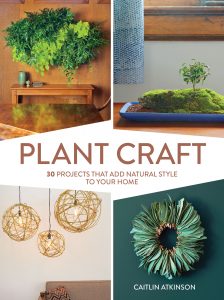 Plant Craft: 30 Projects That Add Natural Style to Your Home is perfect for the indoor gardener looking for new and creative interior decorating projects using plants. While many of the projects are rather ambitious, author Caitlin Atkinson presents each of the 30 tasks very clearly and carefully. Each project includes a materials list, a tools list, and detailed instructions accompanied by photographs for each important step.
Plant Craft: 30 Projects That Add Natural Style to Your Home is perfect for the indoor gardener looking for new and creative interior decorating projects using plants. While many of the projects are rather ambitious, author Caitlin Atkinson presents each of the 30 tasks very clearly and carefully. Each project includes a materials list, a tools list, and detailed instructions accompanied by photographs for each important step.
Projects range in complexity from creating clay plants for a cactus garden to constructing a planter inside of a wooden bench. There is also a brief section at the start of the book related to houseplant care as well as a plant list of the species and genera of plants used in the book. Experienced home crafters will draw inspiration from the creative projects Atkinson shares, while novice home-decorators can find success with smaller, less ambitious exercises.
Read More
Posted in From the Library on December 12 2016, by Esther Jackson
Esther Jackson is the Public Services Librarian at NYBG’s LuEsther T. Mertz Library where she manages Reference and Circulation services and oversees the Plant Information Office. She spends much of her time assisting researchers, providing instruction related to library resources, and collaborating with NYBG staff on various projects related to Garden initiatives and events.
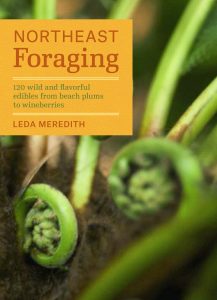 Foraging wild edibles is a lifestyle trend that can’t be ignored. If you’re looking for some guidance about foraging plants, the books below may be just the introduction you are looking for.
Foraging wild edibles is a lifestyle trend that can’t be ignored. If you’re looking for some guidance about foraging plants, the books below may be just the introduction you are looking for.
When learning a new plant in the field, one of the first questions I usually ask is, “Is this edible?” When my botanist companion happens to be there, his answer is typically, “You can eat it,” sometimes followed by a statement about the plant in question not being very tasty, and perhaps that it contains known carcinogens. As a result, I don’t tend to do a lot of foraging. While the practice intrigues me, it also brings to mind a slew of questions. What part of a plant can I eat? What about look-alike plants that are poisonous? How much can I (or should I) gather from a native plant population? Should I forage native plants at all?
Read More
Posted in From the Library, Shop/Book Reviews on December 6 2016, by Esther Jackson
Esther Jackson is the Public Services Librarian at NYBG’s LuEsther T. Mertz Library where she manages Reference and Circulation services and oversees the Plant Information Office. She spends much of her time assisting researchers, providing instruction related to library resources, and collaborating with NYBG staff on various projects related to Garden initiatives and events.
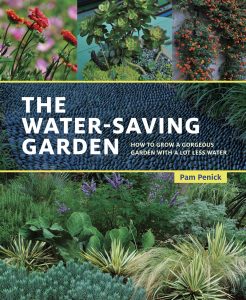
Gardening with less water and drought-resistant plants is currently a relatively hot (but not dry) topic in the world of horticulture. Two new books, The Bold Dry Garden by Johanna Silver (with Timber Press) and The Water-Saving Garden by Pam Penick (with Ten Speed Press) address this topic in very different ways.
The Water-Saving Garden is an all-around excellent book for those who already have existing gardens or who are in the process of designing and/or installing new gardens and are looking for water-saving landscape design ideas. Not so much a how-to guide as it is inspirational, this book offers practical advice and projects for garden designers and home-owners alike. The projects suggested are very modular, and even those who don’t have a lot of space to work with or redesign may find inspiration The truly inspired will find enough projects to redesign an entire yard or property.
In many cases, especially when hardscaping is concerned, supplemental reading would be needed to complete the suggested projects. Ultimately, Water-Saving is a very nice introduction to some possible water-saving projects for the gardener.
Read More
Posted in From the Library on November 29 2016, by Esther Jackson
Esther Jackson is the Public Services Librarian at NYBG’s LuEsther T. Mertz Library where she manages Reference and Circulation services and oversees the Plant Information Office. She spends much of her time assisting researchers, providing instruction related to library resources, and collaborating with NYBG staff on various projects related to Garden initiatives and events.
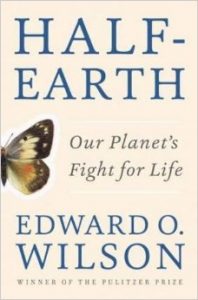 Half-Earth: Our Planet’s Fight for Life is the newest book from acclaimed biologist E. O. Wilson. In addition to Half-Earth, Wilson has authored dozens of books. Unsurprisingly, Half-Earth has echoes of Wilson’s other environmental works. With that in mind, this new book is still a very good stand-alone book about environmentalism, biology, and natural resources. It’s written accessibly both for those working in the sciences and for non-scientists who are eager to learn more about environmentalism and conservation. Half-Earth is ultimately quite philosophical, but includes the framework of a practical call to action.
Half-Earth: Our Planet’s Fight for Life is the newest book from acclaimed biologist E. O. Wilson. In addition to Half-Earth, Wilson has authored dozens of books. Unsurprisingly, Half-Earth has echoes of Wilson’s other environmental works. With that in mind, this new book is still a very good stand-alone book about environmentalism, biology, and natural resources. It’s written accessibly both for those working in the sciences and for non-scientists who are eager to learn more about environmentalism and conservation. Half-Earth is ultimately quite philosophical, but includes the framework of a practical call to action.
Wilson writes with great conviction, and Half-Earth is replete with wonderful passages in praise of science. This is a sobering yet useful book to read when so many science writers and others are touting the value of “novel ecosystems” and downplaying the problems associated with invasive species. Wilson doesn’t sugarcoat the challenges that the environment currently faces—the Earth is in trouble in many ways, overpopulation not the least of its worries. There are no simple solutions. The first step is to be educated and informed about the world around us.
Read More
 Jan Johnsen’s The Spirit of Stone is a new book from Pittsburgh-based publisher St. Lynn’s Press. Johnsen, an instructor with The New York Botanical Garden’s Adult Education Department, brings 40 years of experience to bear in her newest book. In the introduction of The Spirit of Stone, Johnsen writes:
Jan Johnsen’s The Spirit of Stone is a new book from Pittsburgh-based publisher St. Lynn’s Press. Johnsen, an instructor with The New York Botanical Garden’s Adult Education Department, brings 40 years of experience to bear in her newest book. In the introduction of The Spirit of Stone, Johnsen writes:








